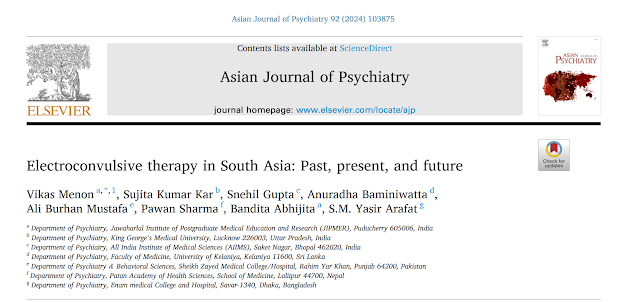ECT in South Asia: A Review of Practice
Out on PubMed, from authors across Asia, is this review:
Electroconvulsive therapy in South Asia: Past, present, and future.
Asian J Psychiatr. 2023 Dec 17;92:103875. doi: 10.1016/j.ajp.2023.103875. Online ahead of print. PMID: 38157713 

The abstract is copied below:
The practice of electroconvulsive therapy (ECT) varies both between and within countries. We aimed to review historical and current trends in ECT practices, perceptions, and legislations in South Asia, a region with a high burden of mental illness and suicide. We searched MEDLINE (PubMed) and Google Scholar databases for relevant literature on ECT from each country. Additionally, a team of country-specific investigators performed supplemental searches and contacted key country contacts for relevant information. Relevant data were abstracted under the following headings: ECT practices, perceptions, and legislations. Knowledge gaps and research priorities were synthesized. Modified bitemporal ECT, delivered using brief pulse devices, was most commonly offered across institutions. Schizophrenia, not affective illness, was the most common indication. Electroencephalographic monitoring of seizures was rarely practiced. Thiopentone or propofol was preferred for anesthetic induction, while the favored muscle relaxant was succinylcholine. In India and Sri Lanka, perceptions about ECT were largely favorable; not so in Pakistan and Nepal. Only India and Pakistan had laws that governed any aspect of ECT practice; ECT practice guidelines were available only in India. There is a lack of research on efficacy, ECT in special populations, continuation ECT practices, and interventions to improve ECT-related perceptions. Most regional institutions offered modified brief-pulse ECT, and schizophrenia was the most common indication. Knowledge of and attitude towards ECT varied between countries. There is a need to develop a regional ECT consortium to facilitate uniform training, advocacy efforts, and the development of regional practice guidelines.
Keywords: Asia; Attitudes; Electroconvulsive therapy; India; Neuromodulation; South Asia
The review is here.
And from the text:

Huh?
I did learn something new: that a synonym for unmodified ECT is "direct ECT."
Kudos to these authors and the Asian Journal of Psychiatry for their efforts to promote ECT practice.




Comments
Post a Comment